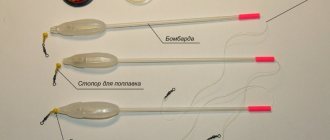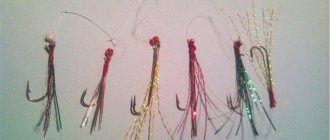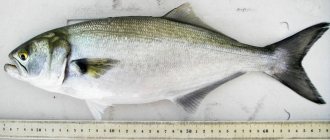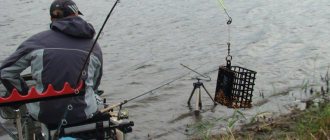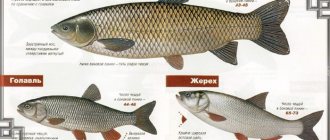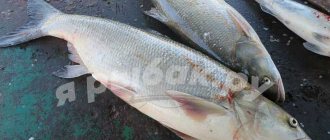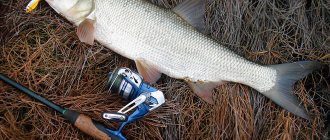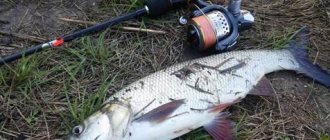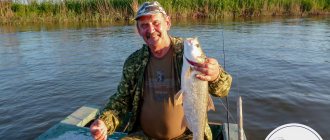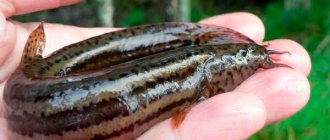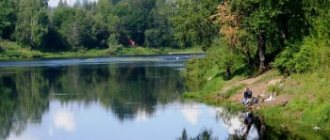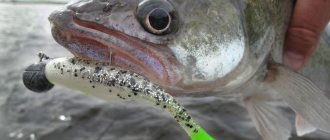Yuri 09/14/2020 408
There are legends about fishing in the Astrakhan region. Many species are found in local waters. Numerous bases provide the opportunity for both amateur and professional fishing.
One of the most desirable fish for any fisherman has always been asp. Due to its rather large size and excellent taste, the asp has always been almost a trophy specimen in Astrakhan. Each fisherman tries to catch an asp that another fisherman has not yet caught.
The main feature of catching local asp
When I first saw the water of the fast-flowing channels of the Delta, I was seriously puzzled. In our area, with such transparency, they don’t even think about spinning. It is simply impossible to catch anything in such water. Fishing can only be done on the bottom, or on a float in areas of weakened current. Water - station coffee with milk photo 6). Like during the peak of the spring flood somewhere in Luga or Meta. You lower the wobbler near the side - half a meter from the surface you can’t even see a damn thing about it. In some places the transparency is better, in some channels where the current is slower, in some places it is worse, but in general the picture is approximately the same.
It turned out that all this is normal, as it should be. This leads to one of the main advantages of asp fishing in these conditions - fishing distances are reduced to almost minimum. If an asp patrols along the very surface, then, of course, he sees something, but the safety distance he maintains, compared to the mounted asp of our rivers, is simply ridiculous. It can be easily reached with a relaxed cast at 30 - 40 m. This distance to the striking asp is quite enough for it not to be afraid of you (photo 7). If the asp walks or stands a little deeper, on a meter, then he is no longer afraid of anything. And it can actively hunt even ten meters from the boat. A couple of times an asp took a three-ruble note from me when there was a meter of cord left from the tip of the spinning rod to the spinner, that is, while taking out the bait. From somewhere far away, the asp was following the lure - and couldn’t resist at the last moment. At the same time, neither the sun in the whole sky, nor the calm smooth current, nor the boat casting a shadow, nor the people standing at full height bothered him. (In our area, for example on Meta, I saw this only a couple of times, and then in conditions of very late evening and difficult surface currents, and the size of the fish was more modest.) One of the main tactical fishing schemes is based on this basis - rafting, when drifting a short distance from the shore and casting short casts around the coastal shelters, you can count on catching a very serious asp.
Tackle for catching spring asp
We must not forget that the asp is a fighter. That is why the gear must be quite durable. The asp not only actively grabs the bait, but also fights for a long time, making truly strong jerks. An asp can easily snatch the spinning rod out of the hands of an unprepared person.
When lure fishing with a spinning rod, preference is given to a long-range rod of 3-3.3 meters, a blank, equipped with reinforced rings of large diameter. They will help when catching a predator. Instead of fishing line, use 0.15-0.18 braid, while doing without a leash, since the asp has no teeth, the bait is tied directly to the cord.
Modern fishermen are increasingly using bombards. The selected rod should be 3.5-4 meters, the reel should be inertia-free.
In some cases, you can use regular float tackle. The rod is 6-7 meters, the same inertia-free reel, only instead of conventional floats, pea floats are used. They do not arouse suspicion among a cautious predator.
As bait for asp, you can use imitation small fish or insects. Although many cases are well known when a predator took sweet corn and even bread.
Catching asp for a beginner, just like for a professional, is an exciting business, but not always successful. But if you know exactly where to cast the bait, then the success of the enterprise is guaranteed. People who have been helping novice fishermen-tourists at the Sazanya Bay base for many years will help you find such a place. No one will be left without fish.
TAGS:
The main advantages of catching asp in summer
Asp, in most regions, is a fish that can be caught all day long. Moreover, unlike other species that tend to be active only during low light hours, the asp has an excellent appetite all day long. Very often the largest asp is caught when the sun is hanging at its very zenith (photo 8).
The asp has no time to “act like an intellectual”; he is the most active predator, a car thief, with maximum energy consumption in the hunt - and the asp needs a lot of food. And the day on the Lower Volga is not very long even in the middle of summer. And in our area, on the same Vuoksa, even a June afternoon does not stop it. Although, it would seem, he could have rested during the white nights. I personally observed twice how asps were dragged out under the “tester” in the period from 12 to 14 hours. So in Astrakhan he has no time for sentimentality. Already everyone, except the perch, is leaving for a siesta, the temperature is 40 - 45 degrees, and the asp, you know, is threshing bleak. The only condition is more or less good, and most importantly, stable weather. Although before its sudden change to an unfavorable one, asp sometimes tend to significantly increase food activity, and in different regions, and you can get into a good deal. Although short-term, after which a phase of complete apathy will begin.
In mid-summer, few people go to the Delta, believing that there is nothing much to do there. It's low season. Many bases are empty. They even close completely for this period. The sun is merciless. The heat is terrible. Water that won't keep you cool. During the ripples the fish catch in the mornings and evenings. It's about the same in the ducts. Pike perch are semi-passive. Carp and catfish focus more on twilight. And only asp can be continued to be caught, no matter what. And it even makes sense to go specially for him at this time. When there are very few boats on the water, there is therefore no competition for fish. This is one of the important conditions for calm and effective asp fishing with a spinning rod. After all, there is nothing more upsetting for the asp hunter when a couple of boats with over-aged idiots and screaming girls on board fly past a flock of large asp that has just gone hunting.
Major caveat
If you are going to Astrakhan at the height of summer, especially for asp, you must be prepared in terms of clothing. Here you don’t need to think about insulation, protection from storms or rain (although having a light, full-fledged raincoat will not hurt at all: not from a thunderstorm, but it will protect you from the head wind when the boat rushes at dawn to the cherished points at maximum speed). And the heat in Astrakhan is very easy to bear.
The climate is sharply continental, even though the Caspian Sea is nearby. And the 45 degrees there are no worse than the St. Petersburg “thirty”. Our task is to take care of maximum salvation from the merciless sun, especially on water, which increases your radiation dose by reflection from its surface. The simplest and most correct thing is to look at how those going fishing in the tropics dress, and then buy the same thing for yourself. When this is not possible, you can get by with the public one. If we talk about underwear, the main requirements are as follows: it should be long, dense and light. From natural materials, if possible - cotton and linen (photo 9).
No shorts or T-shirts! Only full-length trousers and shirts. I somehow relaxed and decided to spend just a couple of hours in a T-shirt at noon. Even my forearms managed to burn during this time; it took two weeks to remove the skin from them. Although I don’t suffer from sunburn at all in my native climate. The headdress is also very important. Its job is to protect your ears and neck from the midday sun. A simple baseball cap is far from the best option. Toasted burgundy “ears” are little better than a toothache. Therefore, either a cap with a long flap, or a Panama hat, or a hat with a wide brim. Feet should be covered with socks if shoes are open. Light gloves are also advisable - they won't hurt.
And of course, don’t forget about glasses. At the same time, with the strongest UV protection. Again, we look at equipment for sea tropical fishing. There these are usually glasses with a mirrored outer coating. In most cases blue or green. Only they are guaranteed to protect your eyes, no matter how much you catch.
Tackle and bait for asp fishing
Kastmaster is one of the best spinners for asp
It is recommended to use a spinning rod from 3 m in length and a cast of 50-70 g. A spinning reel with a large spool from 3000, or a multiplier for long range. Remember to wind the line almost to the edge of the spool so that the bait flies as far as possible.
The asp does not have teeth that are dangerous for biting the fishing line, however, take care of its strength. You can use either regular monofilament line from 0.2-0.25 in diameter or braided line.
Equipment for asp fishing can contain a variety of baits and fishing methods:
The castmaster is the best bait due to its weight and long casting capabilities. When fishing for asp, it is recommended to use a castmaster weighing at least 30 g .
Devonian. This bait is not so popular among fishermen, but it is capable of showing good results when catching this large predator. Be sure to use a swivel in the tackle so that the Devon does not twist the line. This bait is quite weighty, which allows you to cast it over long distances.
Spinner spoons for pike weighing 30-45 g have also proven themselves well when catching sheresper.
Jig baits should also be in the spinner’s arsenal, especially during the period of deep-sea asp fishing in the spring.
Catching asp with a popper and wobbler can also work well. When guiding the wobbler, try to achieve the effect of rarely striking the bait on the bottom. The disadvantage of these baits is the lack of weight for long-distance casting, but you can attach them to jig rigs, for example, to a retractable leash, and the casting range will increase.
Sbirulino. Tackle with bombard and streamer
Bombarda (or sbirulino) is also a very effective tackle, containing a large float that can be easily cast over a long distance, and the tackle moves along the top. Sbirulino is a float with a large carrying capacity.
Boat/sleigh. Another unique tackle that allows you to successfully catch asp and chub.
Front sight/wabby/streamer. The fly often acts as a secondary bait in the tackle and is attached to a leash in front of the main bait, half a meter from it. To prevent the line from twisting, you can use a swivel. Also sometimes they use spinner spoons with feathering like a fly near the hook, this can also give a positive result during fishing. A wabik is a bright fly with a double (hook). The streamer is another type of fly with dense plumage.
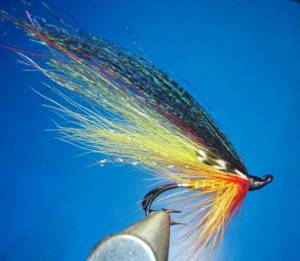
3 types of asp flies
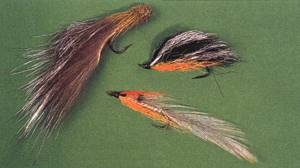
Dark streamers
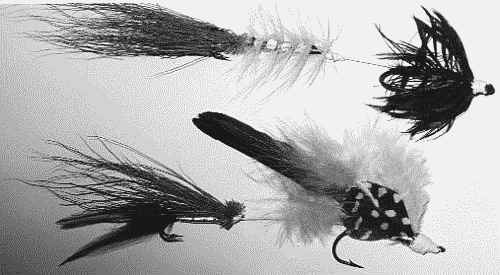
White streamers
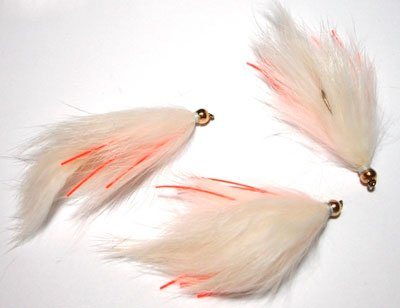
5 types of flies for asp
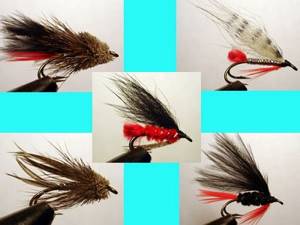
Fishing with live bait . Asp is a predatory fish and its main prey is bleak, topwater and other small fish. There is quite a lot of gear capable of catching fish no more than 5-6 cm long on a hook.
It can be:
- float rod,
- bombard,
- bottom tackle for fishing in shallows,
- bait on one of the spinning baits.
Asp can also be caught well with jig baits in the spring. How to choose a spinning rod for jigging, types of rods and fishing tips. Video instructions for installing silicone baits - 4 parts of practice. You can read about how to choose an echo sounder for fishing from a boat or shore in this article.
Where to look for and catch local asp
Just going out on the water and easily catching an asp with sabers drawn, as they say, for a fool, is unlikely to succeed. If only you're very lucky. For example, if you notice a single hunter cruising along the shore in the midst of an active meal, count him and throw the right bait at the right moment. Or you’ll come across a “battle”, a classic one, marked by screaming seagulls, which can be seen and heard hundreds of meters away. But in this case, most likely, the asp will be massive, but not large, in the “keel” area, otherwise you might even run into a completely “herring” one.
For warming up, of course, it’s not bad, but it will quickly get boring, because a medium-sized asp is a weak fighter even in the warm water of the lower Volga. It begins to show real resistance when it reaches a mass of about 2 kg. This is becoming a completely different fish - strong, fast, and takes a long time to tire. It shows maximum agility, approximately the same as a pike - at 3 kg. Then it begins to put more pressure on the mass and area of its body and caudal fin. To catch just such an asp, you need to know where to look for it. It’s good when there is a huntsman who knows how and where to catch the big ones, but it’s better that he does this himself periodically. Then your time, which, as we know, is money (and even more so money, often quite a lot), will be spent as efficiently as possible. After all, each base has tens of kilometers of river land, be it sections of banks, wide or narrow channels of the Delta. And sometimes during the day, fishing points are scattered at a distance of 30 - 40 km. Now imagine how much time it will take to independently explore such a water area! Especially if you do this in the middle of the day, when asp activity on the surface is minimal and, in addition, a decent wind is blowing. But let’s say there’s a problem with the rangers. Let's go on an independent search. What do we pay attention to?
Features of asp
In order to understand how to find a place for successful fishing, you need to know a little about the habits of this fish. Asp is capable of reaching speeds of up to 79 m/h. This speed allows him to fight the fastest currents. The fish likes to hide in fast-flowing channels, near flooded snags, but always stays in the main, fastest stream.
Once such places are found, you can begin to identify the asp. The predator feeds on the smallest fish. He cannot swallow a large one, since his throat is narrow. To catch this fish, he drowns it. This is exactly what unscrupulous fishermen do, only not on such a large scale. Having a very powerful tail, the lower part of which is longer than the upper, when flying into a school of small fish, the asp slams its tail forcefully into the water and stuns several of its victims. It is from these splashes that you can understand where to throw the tackle. Seagulls can also point to the asp’s hunting area and try to steal stunned fish from the predator.
Rifles
Rolls - it must be said right away that the concept of “rolls” in the Lower Volga version is very different from the same in our northern version. If we approach a riffle here, it is usually a rapid current that nothing can hide, a slope of the stream noticeable even to the naked eye, and often additional sound accompaniment. In the Delta, you can often swim along a riffle and not notice it at all if there is no calm (photo 10). It can be determined in most cases only by the characteristic traces of flow turbulence that appear on the surface. These are the so-called “mirrors”. But the “mirrors” are not the ones that are familiar to pits and waterways, where they wander, protrude and are adjacent to whirlpools. The ones we need are almost stationary, and are formed in a direct flow at those points where the river stream hitting the bottom obstacle is reflected and rises to the surface. This very bottom obstacle does not necessarily go from bank to bank; these are not northern rivers with a stone or gravel bed. In our case, the width of the riffle can be only a couple of tens of meters with a total width of the watercourse of 150 meters. And this makes orientation even more difficult. The whole river is like a river, and only in the middle does it turn out that there is something extremely interesting. And you swim along the shore. But sometimes the roll goes across the entire channel, especially if it is not very wide.
Since Astrakhan is located generally below the level of the world ocean and on entirely soft sedimentary rocks, any transverse rise of the bottom by a couple of meters is already a rapid in those conditions. And usually the depth at its top is one and a half to three meters against the background of the surrounding three to seven. After a riffle, sometimes there may be a compact channel hole, or there may not be.
In any case, the asp appears in the area of the riffle during the day, unless the weather has any special surprises. In larger or smaller quantities, and the average size of the asp, depending on what is not clear, can change significantly. There is just no guarantee that the asp will be somehow active at the moment of your appearance. Therefore, it is necessary to constantly check this point. Today the asp will emerge at dawn, tomorrow at noon (photo 11), and the day after tomorrow - when the sun has already fallen below the horizon.
Moreover, each roll has its own life. For example, we caught here yesterday morning, we caught a good amount of large asp and a lot of them. The asp walked without much of a “fight”, but its powerful backs were constantly showing up at the surface - and it was not difficult to carefully present the lure right under the noses of the cruising asps. And on the next rift, a few kilometers away, another boat observed no bites and zero movement on the surface. The next morning, of course, everyone is here. But no! Silence. There's a call here. The picture has changed. It's the other way around. The next roll started working. Asp, from his neighborhood, wanted to eat this morning. Let's go there.
Returning in the evening, we decided to check the morning point. And just when the sun had already touched the tops of the trees, it began! The asp came out abruptly and en masse. The whole thing is from two to three kilos. And he was caught almost through the cast. Having arrived at the base in the evening, we learned that the nearby “delicious” points, not only the rifts, at the same time responded with complete lack of fish for those who wanted to catch an asp there. The most famous riffles in the evenings are most consistently visited by active, numerous fish - and it is better to focus on them at this time. You can catch the most impressive amount of asp in a minimum of time. Another good thing about fishing in these areas is that there is always a chance to catch a single, insignificant asp sticking to the bottom near the top of the riffle. And at any time of the day. On the most “trump” rifts, even if the fish are completely passive on this day, you will still, even if you suffer, catch your asp. Because he is registered here.
And another very important addition. Riffles are mainly a phenomenon of that section of the Delta where there are predominantly full-fledged solid shores. That is, the top one. If you climbed deep into the Delta, already to the Caspian Sea itself, then you need to focus on other points.
Large riverbed snags
Large channel snags - Floods carry a lot of wood. After all, the banks are washed away, they collapse, and trees fall into the water along with them. Or their remains. Sooner or later they settle to the bottom. If this happens in the shallow lower Volga channels on the main current, and such a snag becomes clearly visible due to the fact that it comes almost to the surface or even sticks out of the water, then a very interesting and easily readable point for catching asp is formed (photo 13).
Behind a large snag, a pronounced zone of weakened current is formed, which attracts all the surrounding fish. The lower zone is occupied by catfish and carp. A lot of small items collect at the top. The asp is somewhere in the middle layer. A large flock of asp, of course, cannot fit here, but several individuals are sure to hang around nearby. Sometimes they can appear on the surface, especially in the evening, but this is not a necessary condition for fishing. Sometimes this point is favored by the most seasoned fish. Here there is shelter, protection from strong currents, and food is always abundant above your head: a couple of movements and you are full. In such a place there is a chance to hook an asp far beyond 5, or even 7 kilos. And this happens, albeit infrequently, but quite regularly.
When sailing past such a snag, you should never ignore it. It is imperative to anchor and make several control casts. It is better if there is more than one spinner in the boat - use fundamentally different baits, for example, Cas. Maybe something will go off at the moment. Sooner or later you will get lucky. In the morning, and especially in the evening before sunset, half an hour or an hour should be given all your attention to such a point, if you find yourself on it. The asp's exit to hunt can be sudden, short-lived and very active. You shouldn't yawn here. The number of trophies during the period of this output may correspond to the number of casts made.
For a large asp,
It is better to catch large asp in the Middle Volga in the spring. It is at the beginning of the season, when nature has already woken up from winter hibernation, but the heat has not yet come into its own, that the chances of setting a real record become very real. The time has come to catch your luck by the tail, and the asp, according to the rules, by the mouth!
The most productive fishing occurs during the period from the beginning of the water decline until the normal summer level is established. In the Saratov region, the most “fishy” period occurs during the May holidays. It is in early May that spawned fish of many species begin to migrate en masse from the floods into deep rivers and reservoirs. At the same time, tons of fry “merge” with the adult fish, which has a very refreshing effect on predators. The spring ban on spinning fishing in the Volga region is not introduced every year, and it usually falls on other dates, so from the point of view of legality, May fishing is completely legal. Asps spawning on the main Volga retreat to quiet backwaters, whirlpools below the rifts, where they rest after a stormy spawn. The spring stops of the swift predator are numerous - they are cherished and guarded like the apple of an eye. A week before the expected fish run, “scouts” begin to go to secret “points” every day, sometimes in the morning and evening. There are two tasks. Just don't miss the start of the action and don't get caught up in front of your competitors! Special secrecy pays off well - from year to year, in the same places, spinners are pleased with solid trophies. There is such a work place and ours caught the first asp in early May. The closest “red” day of the calendar was May 9, Victory Day. Early on a holiday morning, when the city was still asleep and lonely street cleaners were tidying up the deserted streets before processions and parades, we were already rushing by car in the direction of the Volga. The blood of the spinners was seething and boiling in anticipation of a real battle. The foam rubber fish have been cut long ago, doubles No. 2/0 are glued into them, fresh two hundred meters of strong braided fishing line are prudently wound - the Volga asp does not like to joke. Just in case, 30-40 gram Kastmasters are also stocked. Smaller spoons are not suitable for the spring stream. This is the river! Dark waters rush rapidly, forming powerful eddies and whirlpools. This is a roll. Because of the icy water, the fish feel uncomfortable on the rapids, so we are lower. Under the riffle, the main stream sharply departs from the shore, and right above the nearby drop, the “return” lazily pulls. Exactly what is needed! The place simply “smells” of a large asp. We quickly collect spinning rods. We are caught doing this by a local aborigine with a gavrileaf appearance. “We shouldn’t have come! There are no fish,” the “Papuan” “pleases” us and, adjusting the empty backpack on his shoulder, slowly wanders into the distance, swinging an “iron” spinning rod with a Neva reel. But we are not upset. The fact that fish are not caught using spoons (the main working tool of the local “pros”) only makes us happy. We will fish with a JIG, and not with a simple one, but with an extremely heavy one. Oscillating spoons and other light baits will simply sweep wildly in the upper layers of the water, while at the very bottom, in the lulls near stone boulders and clay spits, huge shadows quietly slide. Not alone. Not three. A lot of them. Sometimes the entire bottom is covered with them, sometimes six or seven huge fish are hidden behind each submerged log. And they don’t really care about the “oscillators” flying somewhere in “space” at crazy speeds. They are only waiting for a jig. We came to the huge size of jig heads a long time ago. This was facilitated not only by Savin NG’s seminal publications in “Sports Fishing,” but also by need. As one of my friends accurately put it: “...the slower and more accurately the jig bait moves, according to the angler’s feelings, the faster it carries past the fish...” The crazy current has not been canceled... Therefore, the wiring must be very aggressive. The length of the jig pause should not exceed one second. It is necessary that every meter of the bottom in a promising place be tapped and “scanned” with your bait. Foam rubber fish is most suitable as a universal bait for spring fishing. This is also almost true. It can be made non-snagging - a worthy response to opponents of heavy jig fishing, who accuse us of intentionally or unintentionally catching. It costs a penny, you can do it yourself - in the spring, when there is a spill, there are just a lot of “dead” hooks at the bottom. This summer you can settle down for the night among the huge boulders, but now they are the worst enemies of our baits. And most importantly: the asp perfectly “eats” foam rubber of any size and shape, no worse than the most. Sometimes it's even better. In spring - almost always. Having tied a non-hooking foam rubber to the fishing line on a double with a bunch of two “Cheburashkas” with a total weight of 75 grams, I carefully make the first cast. My spinning is “correct” - a rigid “stake”, with a real test of up to a hundred. Care is needed so as not to shoot off the relatively thin braid. If you put a thicker cord, the total windage will increase so much that even 110-gram Cheburashkas will not be enough for normal fishing. And that's too much. Such a “bomb” can scare away all the fish. It is best to cast a little higher upstream, so that the first contact with the bottom occurs strictly opposite the spinner, perpendicular to the current. If everything is done correctly, then after 2-3 short steps the bait will go on a longer flight, lasting about three seconds before the first touch of the bottom. If the pause is longer, increase the weight. As the bait approaches the shore, the duration of the pauses will increase. This is fine. The main thing is that the “foam rubber” is not picked up by the stream and carried into the upper layers of the water. The weight of the sinker head should be enough to tap the “sub-brow” area. This is what a standard weight jig usually flies through. This is where most of the bites occur. The bite, as usual, occurred on the very first cast. My sixth sense did not deceive me – there was fish here. A sharp poke, a hook and a prolonged crack of the clutch announced the beginning of the first battle. The fast-moving fish, having reeled in about twenty meters of fishing line, stopped, then rushed against the current. This means that the asp was caught according to the rules. The purple fish is always carried to the shore by the current. Meanwhile, the predator begins to get tired. The size is not the most record-breaking - a quick pumping out, and after a couple of minutes the silver fish is already standing in shallow water. Now you need to carefully take the asp by the tail. It is now still in its breeding plumage, its scales are rough, and this method of retention is the most aesthetic and rational. The pocket scale showed 3.2 kilograms. Worthy, but not a record. The asp is released into its native element, and I make a second cast. Touching the bottom, lifting off... hitting, and everything repeats exactly. The second predator is the twin brother of the first. There was “catch”, there will be “release” - a large fish, slowly moving its fins, disappears into the depths. Whether or not to release the caught fish is a personal matter for everyone, but I will warn you that the spring asp is practically “inedible”. Rather than kill such fish for food, it is better to go to the supermarket and buy salmon. Let the asp live; in any case, it would be better to catch him in the fall. It will weigh more, and it won’t be disgusting to eat. The asp was caught well, but clearly too small for Victory Day. Over the next half hour, four more three-kilogram beauties were caught, with friends things were no worse, but I wanted more. We came for a real trophy. There was an urgent need to change the location. A few hundred meters below “our” rift a promising place could be seen. A high cliff, a washed-out shore, and large stone boulders at the bottom... We hadn’t fished there before because of the high water level - there was simply no approach, and it was impossible to fish from the cliff. But now the flood is lower, and it is possible to crawl into untouched lands. What awaits us there, an abundance of fish or a bunch of blind hooks? We could only guess about this. Having barely overcome the last meters of the impassable, littered shore, Andrei and I, an old fishing friend, came out onto a gorgeous lawn: several large flooded trees, a stream of water rushes right through them, forming powerful disturbances on the surface and in the depths. The bottom is rocky, with small clay patches. There must be trophy fish here! While I was changing the bait to a heavier one (the current here seemed stronger to me), my friend made the first cast. A moment later, something incomprehensible happened - his spinning rod, without hooking, sharply bent into an arc, the friction brake of the old reel squealed like a half-cut pig, and Andrei himself, sitting back slightly, with bulging eyes, expressed the entire range of emotions that a person is capable of! The fish didn't even think about stopping. In moments, about forty meters of 15-pound braid were spooled from the spool. A short pause, and the fish rushes downstream again. The river giant, in a new impulse, took another 35–40 meters of a strong cord. But the friction brake was tightened “as it should”, that is, almost all the way! The supply of fishing line on the reel remained minimal; the fight was about to end not in favor of the fisherman. A well-worn spinning rod with dough up to 50 g. curved so menacingly that it was scary to even look at. Pure parabola! And I, like an idol, stand with the video camera turned on and can’t even help. And help was needed later, when, on a strong stream, a large asp with its entire mass reeled in all 120 meters of “thread” that was on the reel and continued to go downstream. The shore at the fishing site was heavily overgrown with bushes and trees; it was not possible to run after the asp. So we passed the spinning rod with the fish beating on the hook to each other on outstretched arms through all these bushes, slowly but persistently approaching the fish that had finally stopped. The large asp's strength gradually dried up, and after another five minutes he allowed himself to be led to the very shore. A quick, confident movement - and the fat predator is grabbed by the hand by the base of the tail. This beautiful specimen weighs almost five kilograms. Andrey's personal record! It’s not good for me to lag behind either, I need to catch up with my friend. We made a lot of noise, of course, but there is hope. I finish my gear and make the long-awaited cast. Exactly in place. Adrenaline in the blood goes through the roof just from the anticipation of a bite. My hands are shaking... the bait moves two meters... four... nine... Frustration is already beginning to arise in my soul when an unknown force suddenly tears the spinning rod out of my hands. I'm trying to make a hook, but where is it going? The most I can do is raise the spinning rod by thirty degrees! The clutch seems to be about to melt from the crazy rotation of the spool. Strong fish are helped by the strongest spring current. It is simply impossible to stop her first impulse! Once, last year, I already tried to tighten the clutch tightly - no matter what! The new fifteen-pound braided fishing line could not withstand the pressure of the double power and burst loudly. I didn't want to repeat the mistakes. The fishing had already been going on for several minutes, when an asp, no less large than Andrey’s, turned sharply and went upstream. I just managed to reel back the meters of line that the fish had won. The danger of flooded trees has passed. Then the banal “pulling of the rope” continued - I bring the nimble predator to the shore, it notices us and shys away back to a respectful distance. And so several times in a row. The shoulder had already begun to numb when the fish finally gave up. The handsome asp was a complete copy of Andrei's record specimen. Well, just 100 grams less. A little bit. And a little bit doesn't count. This is also a victory! We will storm the six-kilogram barrier next year. On Victory Day. We hope he turns out to be like this...
Konstantin KUDINOV May 10, 2007 at 14:00
Shore shelters
Coastal shelters - despite the fact that the asp is a fish of large expanses, it is not at all alien to the tendency to solitude and comfort, and far from strong currents. Asp loves to occupy secluded places almost near the shoreline (photo 14), be it large low-hanging trees, bushes extending into the water, coastal snags, drifts of all sorts of things, and even small pockets in the reed line.
At each such point there is potential. You just need to check them all. Constantly. There aren't too many of them in the Delta to miss. There are some channels, entire kilometers of which do not have any configuration that is so attractive to a serious asp. (After all, let’s not forget that we are in a semi-desert zone - and there are problems with vegetation, even coastal ones.) And there are those where, for hundreds and hundreds of meters, one promising point after another follows practically without intervals and all the fishing here consists of rafting along the shore and continuous fishing of the water's edge. This is one of the two main methods of catching asp in the Delta - raft fishing. And this is done with the help of classic oscillating spinners. The most interesting places, as a rule, are located in rather narrow watercourses closer to the Caspian Sea, because they have quite a decent depth right from the edge. And it’s quieter there, because the banks are difficult to access and heavily overgrown (photo 15). And on the large branches of the upper part of the Delta, it happens that a tree stands overhanging, spreading, with branches extending into the water. It looks gorgeous. You throw it, and under it there is a meter and a bare, flat bottom. And often there are enough people, noisy and catching - everyone wants some shade.
In addition, in small channels with a pronounced current, at any time of the day, even in the absence of special shelters, under the shore you can catch medium-sized foals up to 800 grams. On a small “spinner” or “spinner”. Anything is more interesting than “strangling” perches.
Where to look for asp on the Volga
One of the main and most time-consuming stages is searching for a promising location. The fisherman’s task is to find an area where the asp comes out to feed, and even better, where he lives permanently.
Did you know? Asp meat is a low-calorie product. There are only 98 kcal per 100 g.
Promising places on the Volga:
- Shallow water riffle - the wider the area, the better. Also, the area should have direct access to a riverbed or hole with calmer waters, where the fish can rest or wait out the heat. The depth of the riffle itself must be at least 2 m. Also in this territory there must be a food base.
- Snags or areas with trees hanging over the water.
- Steep shore.
- Thresholds, channels.
- Shallows, reaches and sand spits.
- Flooded bushes in places where coastal jets break.
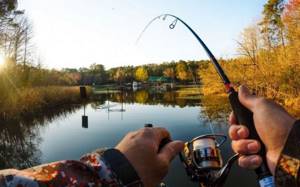
Most often, the asp is located where the currents merge. As a result of the swirling of the whirlpool, small fish, which are the basis of this predator’s diet, are disoriented. This makes it possible for the asp to easily obtain food for himself, with virtually no effort.
Arrows (aka “pants”)
Arrows (aka “pants”) are invariably present objects at the top and bottom of any river island (photo 16). They are interesting for all types of fish primarily because here complexly interacting currents (separating or merging) coexist with rich relief, and often with thickets of aquatic vegetation and settled snags. All this attracts clouds of small things, and, accordingly, a predator. Here the perch eats, and the resident pike is caught, and the asp comes here regularly.
When the arrow has an extensive zone of sediment occupied by grass, immediately followed by a dump in depth and a stream, then the border of the grass, especially in the area of the top, is a promising area for fishing throughout the day. The deposit area on the arrow may be the same as in photo 17. After a couple of steps it will be already with the head. It is at this point that they take the asp almost from under his feet. And often it is at noon, in the thick of it, that such points should be processed, because here an active daytime single asp always appears, which is not difficult to seduce with bait. At the same time, it is not at all necessary to catch “with a splash”. It cruises next to the “greenery” somewhere along the dump and periodically, if necessary, rises to the surface, but it also hunts in the lower layers, and therefore is easy to catch. Sometimes there are no superficial manifestations at all, but the asp nevertheless occurs regularly.
Moorings for ships and landing stages
Moorings for ships and landing stages - these points are tied exclusively to centers of civilization. They are attractive to the asp because here he can always find a large surface shelter, which, in addition, completely protects him from any light. And his food is immediately wiped off in abundance. But there must be a noticeable current at the outer edge. The asp usually stands not far from this outermost edge, but in the shade and close to the surface. And if there is no pronounced anthropogenic activity happening above his head, such as a disco or laundry, then there is always a chance to take him (photo 18).
All you need is for the bait to splash down a few centimeters from the side or wall, maybe even with a slight impact on the side. If you are rafting past such places when everything is quiet (early in the morning, for example, or on a weekend), then cast casts at certain intervals throughout the entire area. The probability of a bite from a good asp is very likely. Well, if you’re not lucky with an asp, maybe you’ll be lucky with a catfish (photo 19). He also likes to sit in the shade. Only in the bottom layer. And bites happen quite often. You just need to let the spoon float to the bottom.
